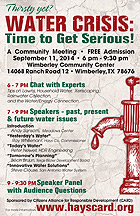|
Water Crisis - Available? Or Not?
(This CARD article ran in the Thursday, July 31 Wimberley View.)
Early Texas settlers dug wells into the earth and found a plentiful supply of groundwater. Using it up seemed impossible. But things change.
Today, in our now highly populated, industry-rich state, over 60% of Texas' water is supplied by groundwater from wells dug into our aquifers. With population growth, the number of public and private groundwater wells has spiraled upward, leading to concern that the underground aquifers are being pumped down much faster than they can be refilled by rainfall.
We now take water for granted. We turn on the faucet and the water flows in seemingly unlimited quantity. It is pure and safe to drink. The cost is low compared to its value to our lifestyle. We know that without water we cannot survive.
Yet we know the water doesn't arrive by magic. Where does our water come from? In Central Texas, the two primary sources are: 1) lakes constructed to collect the rain that runs off the surface of the land –this is surface water; and 2) the underground aquifers that store rainwater that penetrates below the land surface - groundwater. A third source, growing in importance, is rainwater, collected from rooftops and stored in tanks.
Lakes, such as the Highland Lakes along the central Texas Colorado River, can store huge amounts of surface water, but are vulnerable to depletion by several means. First is over-use by consumers such as cities, farms, industry, or environmental/recreational needs. Second is water loss by evaporation. Over a typical three year period the amount of evaporation from the Highland Lakes will exceed the amount of water used by the entire city of Austin annually. Third is sedimentation of the lake's bottom from soil transported into the lake by muddy streams. Over years, lakes lose their storage capacity unless they are constantly dredged. Fourth is seepage of the lake's water into the earth through cracks and fissures. Fifth – the critical factor over which we have the least control – is rainfall, or the lack thereof. Lakes have a defined catchment area and rain must fall within that area to be captured and stored.
Engineers aware of these factors try to manage the lakes' water use accordingly, but as we see from the current situation in the Highland Lakes, drought, or rain in the wrong location, can play havoc with the best laid plans.
Groundwater is rainfall that has permeated into the earth and is stored in underlying sand or limestone rock formations called aquifers. Some aquifers are shallow (near the earth's surface) and refill quickly from rainfall. Others are deep and refill very slowly, sometimes over hundreds or thousands of years. In central Texas the charming but also vital springs that feed our creeks and rivers are supplied by water seeping out of these aquifers.
Why do aquifers fill so much slower than we drain them? Studies have demonstrated that in central Texas only about 3% to 5% of rainfall reaches our underground aquifers. The balance of the rainfall runs off, is captured in lakes, or is held in the upper soil layers, where it is used by trees and grasses or lost to evaporation.
In Wimberley, Woodcreek and western Hays County, drinkable water is supplied by groundwater through companies such as Wimberley Water Supply, Aqua Texas, and Dripping Springs Water Supply. They get the water from wells. Wells get the water from aquifers which, in western Hays County, means from our Trinity Aquifer. Additionally, more than 6,000 private wells supply groundwater to rural properties from the same aquifer. More are being drilled every year.
Think of it as thousands of straws sucking down our once full glass of water, the Trinity Aquifer! As over pumping lowers water levels in the Trinity Aquifer, more and more existing wells and springs go dry; more and more surface streams stop flowing.
Today the supply of water for our area is adequate. But we know additional growth is bringing many more people and businesses. As responsible, foresighted citizens, we must consider how we can assure a reliable supply of water for our own future, and for those who follow us.
Let's find out more about Hays County water together. Citizens Alliance for Responsible Development (CARD) will host a free, non-commercial community meeting, Water Crisis: Time to Get Serious!, 6-9:30 p.m. Sept. 11 in the Wimberley Community Center. Specialists will speak on water concerns, and experts will be on hand with tips for developing sensible personal water use habits.
Keep up with meeting updates on this website (hayscard.org), and help us get the word out with our poster.
CARD Steering Committee
|


